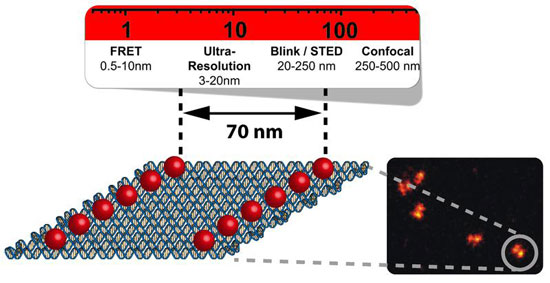| Dec 10, 2012 |
Measuring the nanoworld: Rulers made of DNA
|
|
(Nanowerk News) For only a few years, it has been possible to resolve biological structures down to the molecular scale with light microscopy, termed super-resolution microscopy. This has led to a number of new insights into biological processes. However, there have been limits to the techniques: so far it has been difficult to distinguish between sample specific and microscope specific error sources if the images were blurry. Moreover, different techniques could not easily be compared. This issue has recently been resolved by the Technical University of Braunschweig ("Fluorescence and super-resolution standards based on DNA origami").
|
 |
| The scheme shows a rectangle crafted from DNA with two lines of fluorophores at a distance of 70 nm. With a perfectly aligned super-resolution microscope, these lines can be resolved as is visible in the image on the right. This approach allows the construction of a multitude of structures for various types of super-resolution microscopy. (Image: TU Braunschweig/PCI)
|
|
Scientists from the Institute for Physical and Theoretical Chemistry developed special self-assembled nanorulers. These nanorulers are used to evaluate resolution and light-sensitivity of microscopes on the nanoscale. “In analogy to distance marks on a common ruler, spots with a defined number of fluorescent dye molecules are employed as marks”, the group leader Prof. Philip Tinnefeld describes the main principle. The scaffold of these structures is a long circular DNA molecule which is folded in the desired shape by adding hundreds of short complementary DNA staple strands. Millions of these so-called DNA origami structures can be assembled simultaneously in a single step. Depending on the desired application, the structures can be reprogrammed to host various dye molecules at different positions.
|
|
With these nanorulers the scientists can now evaluate the performance of microscopes and different microscopy techniques. The rulers can be adjusted to different sensitivities and resolutions of all common optical super-resolution techniques. Especially for the resolution range of 6-200 nm, which has become accessible a few years ago, the nanorulers provide the possibility to compare currently competing microscopy techniques.
|
|
This research has been funded by the German Research Foundation (DFG) and the Biophotonik IV program of the Federal Ministry of Education and Research (BMBF). The results possess large economic potential as manufacturers of microscopes (e.g. Leica or Zeiss) started to bring „super-resolution microscopes“ to market. In the future, the nanorulers will be distributed by the spin-off company STS Nanotechnology.
|

